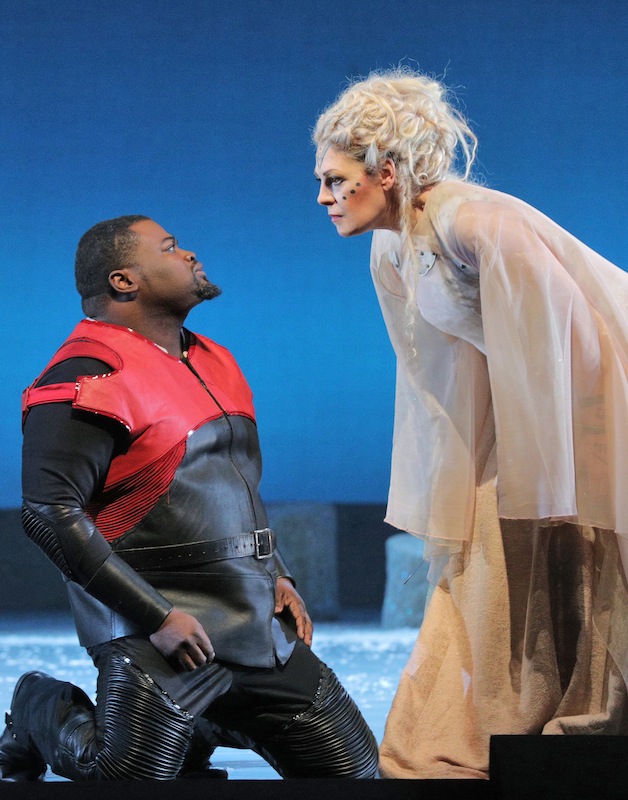Even with Radvanovsky, Lyric Opera’s routine “Norma” fails to catch fire
Norma’s funeral pyre failing to ignite at the climatic end of Bellini’s opera Saturday night at Lyric Opera provided an apt metaphor for the evening on the whole.
With Sondra Radvanovsky taking on the title role of the Druid priestess, one expected to settle in for a great night of bel canto vocalism at Saturday’s opening performance. Instead this Norma was a hit-and-miss affair with fitful highlights by the soprano continually undermined by stagey dramatics and a bizarre and baffling production.
Designer David Korins’ embassy set for Lyric’s Bel Canto in 2o15 was a stunning achievement, but his revisionist take on Bellini’s Norma remains just as bewildering Saturday as it did three years ago when unveiled in San Francisco. The inspiration, says director Kevin Newbury, was taken from Druid rites and the Iron Age.
So the opera, supposedly set in 50 B.C. Gaul, here takes place in what looks like a massive barn or lumber warehouse—finally, a Norma for the forestry industry. The priestess ascends a raised wooden platform to cut her ritual mistletoe from a massive tree branch that hovers over the stage.
The unit set is framed by four towering gray wooden columns; a large door looks out to a winter forest of bare trees as snow descends. A pair of enormous mounted steer heads peer out at the audience. Whatever the historic justification for the production, the set seemed less evocative of ancient Gaul and more like a promising design for a Texas steakhouse chain.
Newbury jettisoned some of the more unintentionally comic elements from this production’s premiere, like rolling Norma’s children on and off stage in a little goat cart. Mercifully gone too is Radvanovsky’s short platinum blond wig, which suggested Jean Hagen’s Lina Lamont in Singin’ in the Rain. (Her new quasi-dread affair has more apt contemporary cool.)
Still, the drab, gray visuals do little to enhance the scenario. While Newbury’s stage direction in general was capable, the handling of the end of the opera–as Norma lights her funeral pyre–was so awkward it gave the impression that some flashy stage effect failed to come off. (On Sunday, a Lyric spokeswoman said that was not the case and the production ended as it was supposed to.)
Following her triumph at the Met last season in tackling all three of Donizetti’s queens, one expected great things from Sondra Radvanovsky in the role of the noble, impassioned Druid priestess. Yet the soprano got off to a surprisingly shaky start Saturday. There were characteristic rapt pianissimos in her “Casta Diva” as well as a stunning descent on arpeggios at the end. But the long line of Norma’s famous incantatory plea to the Druid goddess was repeatedly broken up by extra breaths, with some errant intonation and jarring notes later on as well.
Radvanovsky seemed more herself after intermission, singing with her usual security and floating Bellini’s high lines with pure, creamy tone and elegant style. Dramatically, she did what she could with the scenario of an impassioned love triangle between Norma, Pollione, the proconsul of the occupying Romans, and her close friend, Adalgisa. The singer rose to the final scene with her best vocalism of the night with beautiful singing and fiery dramatic conviction.
Russell Thomas made a mixed house debut as Pollione. While he sang with heroic tone and dedication as the weak-willed Roman proconsul, Thomas’s strenuous style leaned more toward can-belto, scooping up to high notes and lacking sustaining power on top. The tenor was also rather stiff and rudimentary in his acting. Like his costar, Thomas was at his best in the final scene of mutual self-sacrifice, both vocally and dramatically.
As Norma’s friend and not-so-virginal vestal, Elizabeth DeShong proved an admirable Adalgisa. Her wide-ranging mezzo–from high notes to contralto-like dark tones–handled the role’s demands with aplomb. She brought fire to her confrontation with Pollione and blended fluently with Radvanovsky in the extended duet, “Mira, o Norma.” If not quite dramatically plausible as a romantic rival to the tall, attractive Radvanovsky, DeShong made the sisterhood element come across in the women’s scenes together.
Andrea Silvestrelli has had a long and distinguished career but it’s increasingly hard to avoid the feeling that it’s time for the veteran Italian bass to think about retirement. As Oroveso, Silvestrelli seemed tired and listless, providing little fire as the Druids’ leader and the singer’s raw and frayed voice sounded close to tatters.
Hlengiwe Mkhwanazi was a sympathetic and well-rounded Clotilde, Jesse Donner a worthy Flavio.
Ricardo Frizza made a solid debut in the pit leading with energy and lyricism as needed. But the rapt bel canto elegance and whipcrack intensity that his compatriot Enrique Mazzola brought to Lyric’s Lucia di Lammermoor last fall made Frizza’s podium work in this repertory seem decidedly workmanlike by comparison.
Under the direction of Michael Black, the Lyric Opera Chorus provided their usual robust and polished ensemble vocalism to the band of Druids, with the imposing warlike chorus of Act 2 providing one of the few really electric moments of the evening.
Norma runs through February 24. lyricopera.org; 312-827-5600.
Posted in Uncategorized



Posted Jan 29, 2017 at 5:58 pm by Matt M.
Oh! You mean it wasn’t set in a Sizzler? That was my guess.
We’re pretty much in sync on the variable singing and dullish band, although you do think more highly of Radvanovsky than I do. I’ve never liked her raspy tone, her erratic pitch or her histrionic acting, and last night’s performance did nothing to change my mind.
But I also found the direction to be inert and often puzzling, with the chorus shuffling onto the stage for no apparent reason, singing, then shuffling off into the trees or the wings or wherever. My favorite “hunh?” moment was in the first half when four women were enlisted to cross the stage busily to deliver two stools upstage, which the females then had to walk around in order to sit down. The rest of the time, the leads mostly stood around and shouted at each other across the stage.
Honestly, I have no idea what the Lyric is thinking anymore with these half-baked, questionably cast productions.
Posted Feb 07, 2017 at 9:14 pm by Richard Boyum
Well, despite what the Lyric spokeswoman said about the ending on Sunday, it was very clear that Norma and Pollione were trying to get the damn fire lit. A funeral pyre without a fire? That is an odd directors choice. Our two singers finally stood with a brave smile apparently to sing another day as the scene blackout ended the opera.